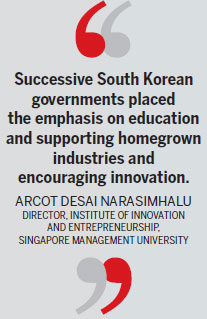Innovative Asia

Whether in China or Bangladesh, the region is proving that new ideas are not the preserve of the West
When it comes to innovation, most people automatically think of the West and in particular the United States, where some top universities have endowments equal to the national debt of some small countries.
With its world-class universities, top research and development facilities, wealth and entrepreneurs willing to take risks, the US has been a draw for the world's best and brightest.
Silicon Valley in California, home to many of the world's biggest technology companies and thousands of small start-ups, owes much of its success to Indian and Chinese talent.
With the emergence of China as an innovation center, however, Asia is beginning to be noticed in this field.
The respected Global Innovation Index for 2014 sees Singapore, South Korea and Hong Kong in the top 20.
Published by Cornell University in New York, the World Intellectual Property Organization and the global business school INSEAD, it examines innovation trends in 143 countries and regions.
The Chinese mainland and Malaysia are moving up the index and they are expected to hit the top 20 before too long.
India, on the other hand, has continued to slip further down the index, dropping from 66th place last year to 76th this year.
When it comes to countries where government policies and corporate performance most encourage innovation, Singapore and South Korea that come out on top, not the US.
Bruno Lanvin, executive director of INSEAD Global Indices, believes "you don't have to be rich to be innovative".
"It is a fact that poor countries have little to inject into the innovation machine," he says. "They have little money, not a lot of talent and even fewer markets, yet they still manage to innovate."
Lanvin cites the Grameen Bank in Bangladesh as a good example of this. Started in the 1970s by Muhammad Yunus, who later went on to win the Nobel Peace Prize, the bank began as a research project providing banking services to the country's rural poor.
"This was an inspiring innovation which has been copied by many countries around the world," Lanvin says. "Lending small amounts of money to poor people so they can start small businesses has been an amazing story and a true innovation in a poor country."
But what has made Grameen a "truly innovative company", according to Lanvin, has been its move into the cellular phone market.
Just like the bank, Grameen Telecom is a not-for-profit company, and it has more than 40 million subscribers in Bangladesh, a country that is still one of the poorest in the region. Those behind the project, including Yunus, believe the mobile phone could become a source of income generation for the country's rural poor.
"These are the sorts of innovations that can take place without massive injections of capital, R&D and advanced university research centers," says Lanvin.
Dan Steinbock, research director of international business at the US-based India, China and America Institute, says international rivalry in R&D is no longer driven only by the US, Europe or Japan, but Asia, and particularly China.
In a recent commentary, Steinbock said that while R&D funding in traditional zones such as Europe and the US is falling, Asia's share of global R&D is climbing.
"For all practical purposes, the region is replacing the North American Free Trade Agreement economies of the US, Canada and Mexico as the global R&D driver. And China is fueling many of these changes," he says.
Steinbock believes that if current rates of investment and growth are any indicator, "China is likely to surpass Europe in total research spending by the end of the decade and the US by the early 2020s".
Throughout the 1950s and 1960s, the US set the standard for prosperity, productivity and innovation, he says.
"Like Britain, Germany and France in the post-war era, China has been engaged in catch-up growth, especially since it became a member of the World Trade Organization in 2001.
"While American, European and Japanese companies were still adjusting to price competition in China, senior executives in the mainland were already internationalizing their operations," Steinbock adds.
Today, the US, China, Japan and Europe account for about 80 percent of the more than $1.6 trillion invested in R&D across the world.
Over the past decade, Singapore - with a population of less than 6 million - has emerged as "one of the most competitive economies in Asia, one of the easiest places in the world to do business and a home for innovation", according to WIPO.
"Research and development has become a cornerstone of the nation's economic strategy," the organization says.
By 2015, it added, the country aims to increase gross expenditure on R&D to 3.5 percent of GDP.
Singapore's tertiary sector - its universities, research institutes and polytechnics - play a major role in spawning the innovation that in turn sustains the city-state's economic achievements, analysts say. And the technology transfer offices established in each of these sectors have been instrumental in moving technology from the laboratory to the market.
"Big countries like the United States have huge home markets so they can develop innovation for the domestic market before taking it to the world," says INSEAD's Lanvin.
"For smaller countries, they can't do that. They need to design innovation the world wants they don't have the luxury of testing the home market first," he adds.
Innovation takes on many forms in Asia, says Arcot Desai Narasimhalu, director of the Institute of Innovation and Entrepreneurship at Singapore Management University.
"If you take India, its innovation focus is on the rural sector," Narasimhalu tells says. It is a very different approach from China, which creates products for a global market."
Asia's rising success as a center of innovation has been a product of necessity rather than design, he says.
"Singapore knew it could not survive purely as a manufacturing center. It had to innovate and move to the next level and become a knowledge-based economy. This was a conscious government decision which had the support of business and indeed the workers."
South Korea "rose from the ashes of war" to become one of the world's major trading nations, Narasimhalu adds, citing how brand names like Samsung, LG Electronics and Hyundai are known all over the world.
"Again, successive South Korean governments placed the emphasis on education and supporting home-grown industries and encouraging innovation."
WIPO says if the level of innovation is measured by the numbers of patents filed at the world's top patent offices, then data shows that the geography of innovation has shifted to Asia.
Collectively, patents filed in China, Japan and South Korea in 2012 amounted to 50.4 percent of the global total. In comparison, the shares of the US and the European Patent Office were 23.1 percent and 6.3 percent of the global total, respectively.
"Even though caution is required in directly comparing IP (intellectual property) filing figures across countries, these trends nevertheless reflect how the geography of innovation has shifted," says Francis Gurry, director-general of WIPO, in the World Intellectual Property Indicators 2012 report.
Of the 100 names ranked in Forbes' recent World's Most Innovative Companies list, one quarter were from Asia.
The magazine has forecast China, India, Indonesia, Thailand and the Philippines to have a combined consumer market size of $8,300 billion by 2020.
"The rise of innovation in Asia is not a win-lose game," Steinbock said. "It will support prosperity and growth in the region, while providing opportunities to advanced economies to participate in both."
karlwilson@chinadailyapac.com

|
Televisions at an electronics fair in Seoul. Many South Korean companies are now global brands, thanks to government investment in innovation and education. AFP |

(China Daily Africa Weekly 10/17/2014 page14)
Today's Top News
- Xi, Macron hold informal meeting in China's Sichuan
- Unity urged to advance Global South development
- Rule of law guards sound business environment
- Resilience of Sino-French economic ties hailed
- Xi, Macron vow to deepen relations
- Tokyo urged to specify its past commitments































